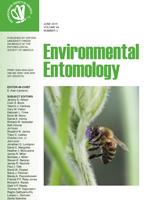Potato psyllid, Bactericera cockerelli (Šulc) (Hemiptera: Triozidae), is an economic pest of solanaceous crops in North and Central America, and in New Zealand. Four genetic haplotypes of the psyllid have been identified in North America. Three of these haplotypes (Central, Western, and Northwestern) are common on potato crops within the major potato-growing regions of Idaho, Oregon, and Washington. Within this growing region, a weedy perennial nightshade, Solanum dulcamara (bittersweet nightshade), has been identified to be an important overwintering host and spring or summer source of psyllids colonizing potato fields. It is unclear whether bittersweet nightshade is a highly suitable host plant for all three haplotypes known to occur in the Pacific Northwest. The objective of the present study was to examine developmental traits and adult body size of all three haplotypes of psyllids reared on potato and bittersweet nightshade. Averaged over haplotype, development times were longer for psyllids reared on nightshade than potato. Duration of the preoviposition period, egg incubation requirements, nymphal development time, and total developmental time averaged 7.4, 5.9, 23.5, and 29.5 d on nightshade and 4.9, 5.5, 22.3, and 27.9 d on potato, respectively. The largest host effects were found for the Central haplotype, which exhibited a substantially extended (by over 5 d) preoviposition period on nightshade compared with potato. Averaged over host plant, nymphal and total development times of the Northwestern haplotype were longer (25.5 and 31.1 d, respectively) than those of the Western and Central haplotypes. The Northwestern haplotype was largest in overall body size, while the Central haplotype had the smallest overall body size, irrespective of host plant. Both sexes exhibited this trend.
How to translate text using browser tools
1 June 2015
Effects of Host Plant on Development and Body Size of Three Haplotypes of Bactericera cockerelli (Hemiptera: Triozidae)
T. Mustafa,
D. R. Horton,
K. D. Swisher,
R. S. Zack,
J. E. Munyaneza
ACCESS THE FULL ARTICLE
It is not available for individual sale.
This article is only available to subscribers.
It is not available for individual sale.
It is not available for individual sale.

Environmental Entomology
Vol. 44 • No. 3
June 2015
Vol. 44 • No. 3
June 2015
bittersweet Nightshade
body size
developmental trait
Potato
potato psyllid haplotype




